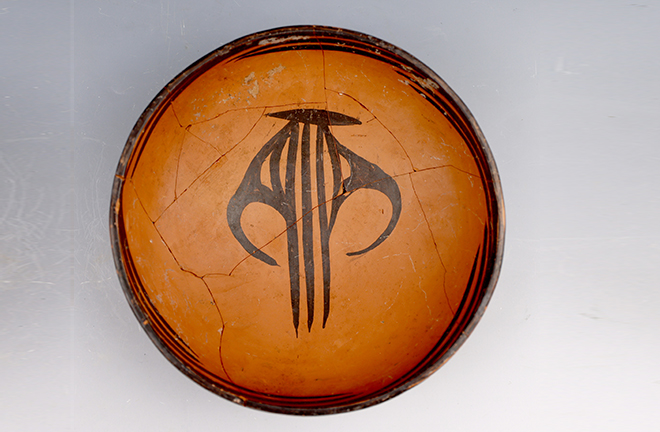Majiayao cultural settlement from Siwa site

FILE PHOTO: A painted pottery object unearthed from Siwa site
The Majiayao culture, dating back approximately 5,000 to 4,000 years, evolved from the Yangshao culture and is divided into three phases: Majiayao, Banshan, and Machang. Recognized as one of China’s most renowned painted pottery cultures, it has also gained international significance. Its core area lies in the Tao River and Daxia River regions of western Gansu Province, with its distribution extending across central and western Gansu, southern Ningxia, eastern Qinghai, and northwestern Sichuan. The culture spread southward and westward, influencing regions such as Yunnan, Xizang, and Xinjiang, incorporating these areas into the early Chinese cultural sphere. The Majiayao culture was also among the earliest to establish exchanges with Central Asia and beyond. Its development arguably laid the foundation for the prehistoric cultures of China’s western frontier, pioneering the “painted pottery road” that facilitated early China-Western cultural exchanges and cementing its role in the formation of Chinese civilization.
Although the Majiayao culture has been studied for over a century, formal archaeological excavations have been relatively limited, and long-term investigations at single sites remain rare. Existing discoveries primarily consist of tombs from the Banshan and Machang phases, providing only a partial understanding of Majiayao society. However, recent archaeological findings, particularly at the Siwa site, have significantly enhanced our knowledge.
Located in Lintao County, Gansu Province, the Siwa site spans an area of 2 million square meters. Its most remarkable feature is a triple moat—characteristic of the Majiayao culture—an unparalleled structure comprising three concentric ditches forming precise 90-degree angles. The enclosed area, nearly 300,000 square meters, contains dense clusters of house remains, kilns, pottery production areas, and stone tool workshops. Excavations suggest that this space likely served as a key craft production district. Additionally, a wealth of finely decorated painted pottery has been unearthed.
New findings suggest that the Siwa site functioned as a central settlement of the Majiayao culture, with its characteristics aligning with the Majiayao phase. Large-scale painted pottery and stone tool production suggest that a well-developed pottery industry and trade networks played a crucial role in the culture’s outward expansion.
The Siwa site and the Nanzuo settlement in eastern Gansu are roughly contemporaneous, both dating to approximately 5,000 years ago. While Nanzuo, also covering 300,000 square meters, contains remains of a “palace city” with massive, monumental architecture indicative of a political center, Siwa’s large moat-enclosed area may have functioned as a craft production center and was therefore an economic hub. This distinction suggests that eastern and western Gansu may have developed along different social development trajectories.
The discovery of Banshan type houses [typical houses found from Banshan type sites, usually square or rectangular semi-subterranean structures featuring indoor hearths and entrances facing east, along with nearby storage pits and kiln sites for pottery production, as well as other architectural remains] at the Siwa site is also of great importance. Early on, archaeologist Johan Gunnar Andersson proposed that Banshan type painted pottery served exclusively as funerary objects, with sawtooth patterns representing “mourning motifs.” In 1959, Yan Wenming, along with his students, discovered Banshan type houses at the Qinggangcha site in Lanzhou, Gansu, where sawtooth-patterned painted pottery was also found, indicating that it was a daily-use item. Since then, further evidence of Banshan type dwellings has been scarce, making the recent finds at Siwa especially valuable. Moreover, several tombs were discovered within these houses, representing an unusual form of indoor burial that warrants further study.
The new discoveries at the Siwa site greatly contribute to refining the chronological sequence of the Majiayao culture while offering deeper insight into its societies.
Han Jianye is a professor from the School of History at Renmin University of China.
